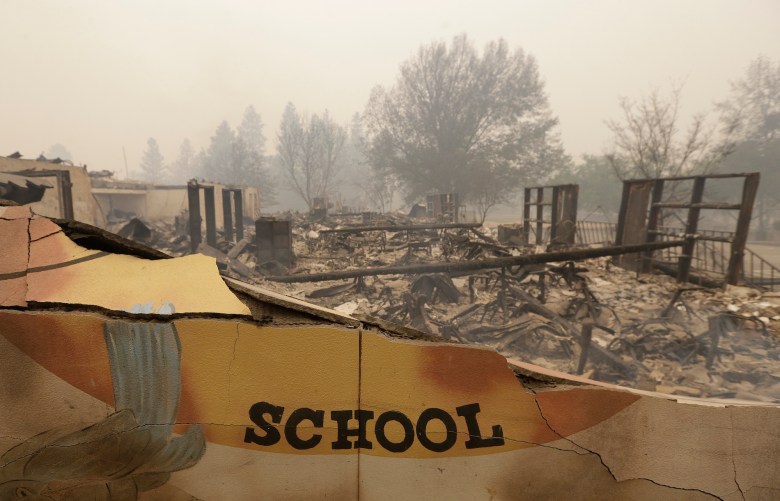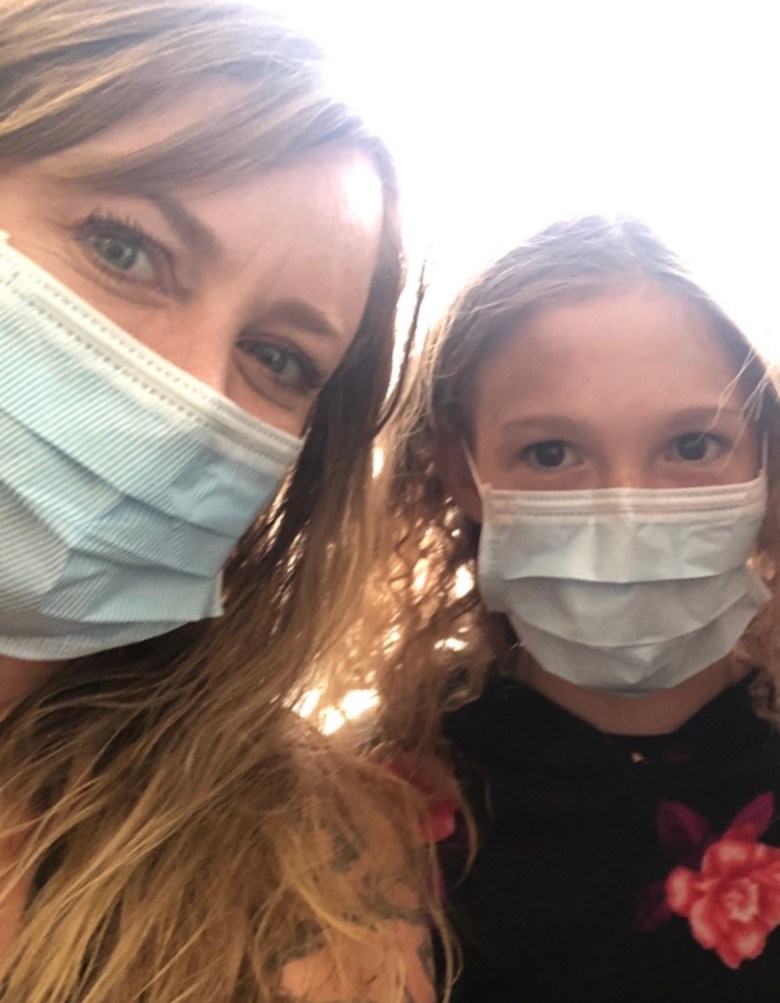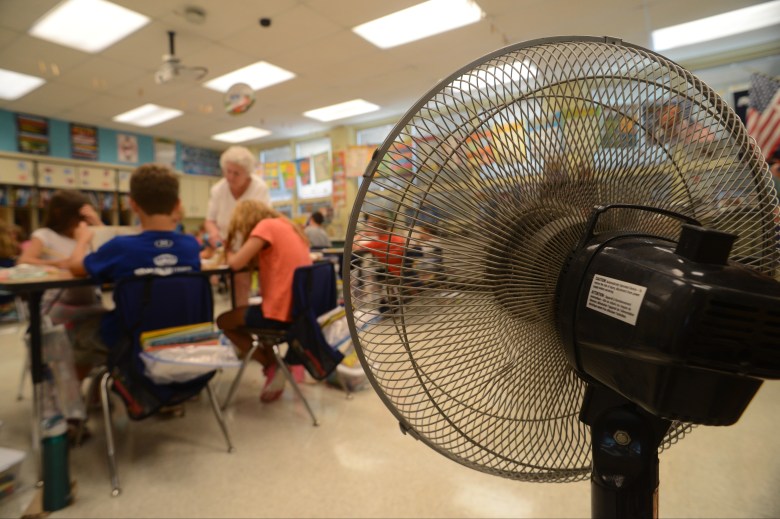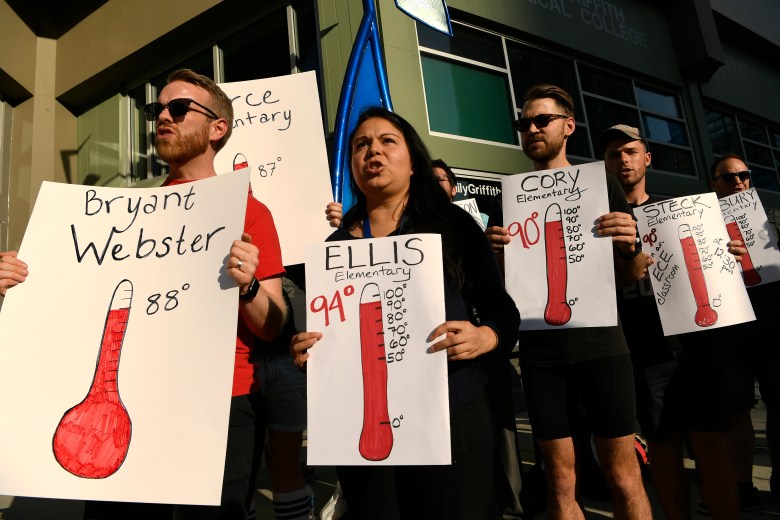The wildfires that ripped through California towns torched school buildings and postponed the start of school as students and teachers were left homeless. A deadly deluge in Tennessee flooded schools and delayed classes as rescue teams searched for dozens of people who’d gone missing. Students around the country were dismissed early due to heat waves and Hurricane Ida, while smoke settled over towns and cities as far east as Philadelphia, sending kids inside for recess.

This summer has brought not only a resurgence of the coronavirus but also some of the starkest evidence yet of the devastating toll that climate change will take on the planet – and on the lives and learning of children. As humans continue to unleash greenhouse gases into the atmosphere, fires, hurricanes, floods, droughts and heat waves are intensifying, in some cases forcing kids to flee their homes and classrooms and shattering their sense of security. School buildings and budgets aren’t up to the task of weathering climate disasters and the experience of living through these calamities is adding to the mental health strains on students already burdened by the coronavirus pandemic.
“Extreme weather is going to increasingly impact and disrupt learning,” said Laura Schifter, senior fellow at the Aspen Institute where she leads K12 Climate Action, an initiative to foster climate-friendly practices and policies within the education sector. “That is something that school leaders and administrators are going to have to grapple with and start to better plan for.”
Megafires

In California, some 70 schools had been directly affected by wildfires as of early September, said Kindra Britt, director of communication and strategy with the California County Superintendents Educational Services Association. One hard-hit district is Plumas, which encompasses Greenville, a mountain town that burned virtually to the ground in the Dixie Fire, the second-biggest blaze in state history.
Terry Oestreich, superintendent of the Plumas Unified School District, said school was postponed from August 23 until after Labor Day as the community tries to recover. Students from Greenville will have the option of attending another school in the district unharmed by the fire.

Whether families will remain in the area is uncertain. Josie Chelotti, vice principal and athletic director for Greenville Elementary and Jr./Sr. High School, lost her house and virtually all her belongings in the fire. She and her daughter, Eva Morris, an eighth grader, are staying with family nearby; Eva will attend another school in the district this fall. Some of her classmates have scattered to Arizona, Texas and Nevada, Eva said.
“It makes you physically ill to go into town,” said Chelotti. “It reminds me of a graveyard.”
Related: The silence of school leaders on climate change
Michele Custer, a school psychologist with Colfax Elementary School, near Lake Tahoe, spent the end of August working with teachers and students who’d been forced to evacuate by the River Fire. Kids in the rural community spoke of losing their horses, cows and other animals in the fire, of seeing the sun glowing red as ash clogged the skies, and of having the start of school – long anticipated after months of remote learning – delayed again. As therapy, students drew pictures of emergency responders who’d battled the flames.
“It feels like we’ve entered into this new reality,” said Custer, who added that, with the wildfires layered on top of the pandemic, some kids might experience complex trauma that could have long-term effects.
In California, where the eight largest fires in state history have all struck since 2017, school leaders have developed institutional knowledge on how to help kids cope with the aftermath of wildfires. Custer, for example, was among the psychologists and counselors who spent time in Paradise, California, after that town was leveled by 2018’s Camp Fire, and is now exporting those trauma lessons to other communities.
“It’s not just affecting the physical health of our students but also the mental health of our students too. I’ve had students come talk to me about how it is hard to concentrate in class when they are trying to find any and all means to stay cool.”
Tay Anderson, a board member and secretary for Denver Public Schools
In Paradise, school district enrollment is 1,524 today, compared with 3,400 before the fire. Even so, the district has a shortage of teachers, substitute teachers and aides, said Angel Allen-Clifford, a school psychologist who has worked in Paradise schools for almost 25 years.
“People are afraid to live here,” she said. Families keep their most precious belongings boxed up, ready to flee at any moment. She’s mailed photographs of her father to her son in San Jose, and other keepsakes to her daughter, who lives north of Seattle.
But the community is rebuilding. Two schools that were devastated in the Camp Fire reopened for the first time this August. For years, staff have been working in what Allen-Clifford likened to “an educator MASH unit,” moving from one temporary facility to another as permanent structures slowly go up. The money and mental health support that flooded in after the fire is largely gone, but each Paradise school still employs two counselors, one specializing in trauma, she said.
Smoke and other triggering events that recall the Camp Fire are frequent. This summer, as the Dixie Fire raged nearby, shrouding Paradise in unhealthy fog, students spent recess indoors while air purifiers roared. A drought exacerbated by climate change has also added to local people’s sense of dread. “We can handle the heat, we’ve even handled the fires, but God help us if we don’t have water,” said Allen-Clifford.
Floods

School officials elsewhere are also finding that their infrastructure is unprepared for climate change. In rural Humphreys County, Tennessee, where record rainfall last month sent floodwaters surging into the local elementary and middle schools, stranding two teachers and killing 20 people around the community, 1,100 students have been left without a place to go to school, said Penny Schwinn, the state education commissioner.
She said the state is trying to ensure that those kids can keep learning. It’s buying laptops, reupping the district’s pandemic remote learning plan, and opening churches and other buildings for students to gather. The youngest kids will be bussed to the nearest elementary, some 40 minutes’ drive away.
The schools, adjacent to a creek, will likely not be rebuilt in their existing locations. “This is their third flood in ten years,” said Schwinn. “There are a number of parents in Humphreys County who’ve … said, ‘Every time it rains, I will worry.’ And that is reasonable.”
Related: How will flooding affect your school?
In the aftermath of the deluge, Schwinn conducted an assessment of flood risks and identified 24 other schools across the state at moderate or high risk of flooding. She has asked the Department of Education to allow Tennessee to use federal pandemic relief funds to relocate those schools, she said. “We have a number of schools in flood plains,” she said. “We should not wait until disaster strikes.”
Nationwide, 6,444 schools are located in counties at high risk of flooding, according to a 2017 Pew Trusts report.
Hot classrooms

Meanwhile, around the country, record high temperatures are making it harder for students to learn. Hot conditions reduce blood flow to the brain, inhibiting cognition. Because a significant portion of America’s schools lack air conditioning, students are being forced to muddle through lessons in sweaty classrooms, if schools remain open at all. In Baltimore, just hours into the first day of school this year, kids were hustled out of hot classrooms and sent home.
Touring school buildings on the first week of school on August 23, Tay Anderson, a board member and secretary for Denver Public Schools, said classroom temperatures climbed into the 90s. “We’ve had students and staff who’ve had heat strokes,” he said. “It’s not just affecting the physical health of our students but also the mental health of our students too. I’ve had students come talk to me about how it is hard to concentrate in class when they are trying to find any and all means to stay cool.”
Of the district’s approximately 220 schools and campuses, 55 lack air conditioning, Anderson said. Nationwide, schools serving predominantly Black and Hispanic students are significantly less likely to be air conditioned. In fact, researchers say the inequities in access to air conditioning explain some of the gaps in test scores between white students and Black and Hispanic children.
Related: Climate change: Are we ready?
That has been the pattern in Denver too. But the district has tried to overcome those disparities by prioritizing schools with a high share of low-income students when it installs new air conditioning units, Anderson said. It is also considering “heat days” when students might study from home remotely, he said.
In Arizona’s Tolleson Union High School District, near Phoenix, outdoor temperatures were above 100 degrees for most of August, peaking at around 115 degrees on August 4, the day schools opened. The district recently upgraded its air conditioning systems thanks to a bond project, according to Devin Del Palacio, school board president. “Not having A/C would be a death sentence,” he said.
“With climate change we are always either in or between disasters. If you are not experiencing it yourself you are aware that someone else is experiencing it and you are aware of the chronicity of it.”
Elizabeth Haase, chair of the American Psychiatric Association Committee on Climate Change and Mental Health
Global warming is altering how kids experience childhood. “We don’t allow our kids to play outside during recess or lunch,” said Del Palacio. “We know students need recreation and unfortunately that’s being limited due to the climate.”
Young people are moving away, not just for better job opportunities but also for cooler climates, he said. Maricopa County, where the school district is located, is one of six Arizona counties identified in a 2020 study as at risk of being uninhabitable within 30 years.
“It’s becoming unlivable,” said Emilio Avila Solis, a 2018 graduate of Tolleson Union High School who now attends Arizona State University. He said many of his former classmates have left.
“I would prefer to stay in the state where I grew up, but if we get to a point where I can’t, I might have to leave,” he said. “Do I really want to raise a child in a state where they can’t jog or play outside in the middle of the day?”
Climate resilience

Educators have been battling for years, often unsuccessfully, for improvements to school infrastructure. In Philadelphia, where many schools lack air conditioning, the Philadelphia Federation of Teachers has estimated that it would take about $200 million to address the most urgent facilities’ needs, including lead abatement and upgraded HVAC units. But money hasn’t been forthcoming.
Laura Schifter’s group, K-12 Climate Action, is encouraging the federal government to work with states and school districts to assess the risks they face from climate disasters and mitigate those harms. The $1.2 trillion bipartisan infrastructure bill that passed in the Senate limited the funds available for school repairs to expenses such as replacing lead pipes, but a reconciliation bill could provide greater support. The Department of Education’s budget proposal this year includes $25 million for a “climate resilient schools” program that make grants available to schools seeking to modernize.
Related: Teaching climate change in a charged political climate
As a group, school leaders have been laggards in acknowledging the climate threat. Relatively few school boards and systems, for example, have agreed to sign climate resolutions promoted by the group Schools for Climate Action, which was founded by Park Guthrie, a sixth-grade teacher and climate activist. When Devin Del Palacio and others tried to persuade the National School Boards Association to adopt such a statement in 2019, the Florida delegation led an effort that stripped the words “climate change” from the resolution and turned it into a statement on natural disasters.
“I would prefer to stay in the state where I grew up, but if we get to a point where I can’t, I might have to leave. Do I really want to raise a child in a state where they can’t jog or play outside in the middle of the day?”
Emilio Avila Solis, student, Arizona State University
Yet today’s students are coming of age in a world battered by disasters on a scale unimaginable even a few years ago. The failure of adults to teach kids accurately about the science behind and threats from climate change, much less about how to mitigate its harms, could add to the mental health trauma young people experience, say educators and psychologists.
“We already essentially need a truth and reconciliation process if we’re going to help young people accurately perceive the situation and build their resilience,” said Guthrie, the sixth-grade teacher and climate activist. “It’s a little like any of our national historical injustices, when we’re not speaking accurately about them, it defers the ability to process them, learn from them and heal from them.”
Mental health professionals say we may have entered a new reality in which almost everyone, including children, is touched by climate change – and routinely so. “This summer has been a wakeup call for what we mean when we say climate change is a threat multiplier, in which many things come together to increase stress on people,” said Elizabeth Haase, chair of the American Psychiatric Association Committee on Climate Change and Mental Health.
“With climate change we are always either in or between disasters,” she added. “If you are not experiencing it yourself you are aware that someone else is experiencing it and you are aware of the chronicity of it.”
This story about climate change was produced by The Hechinger Report, a nonprofit, independent news organization focused on inequality and innovation in education. Sign up for the Hechinger newsletter.




I love this article! If you want to learn more about climate action in DPS (Denver Public Schools), then visit dpsclimateaction.org